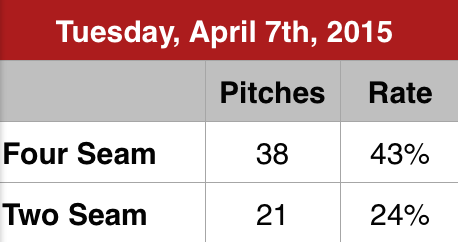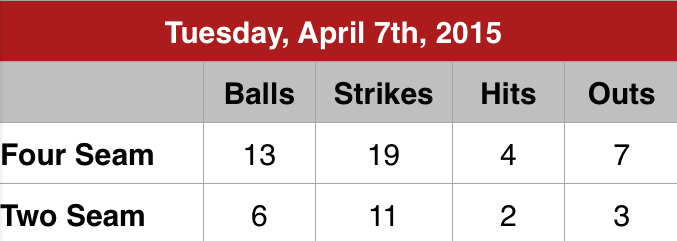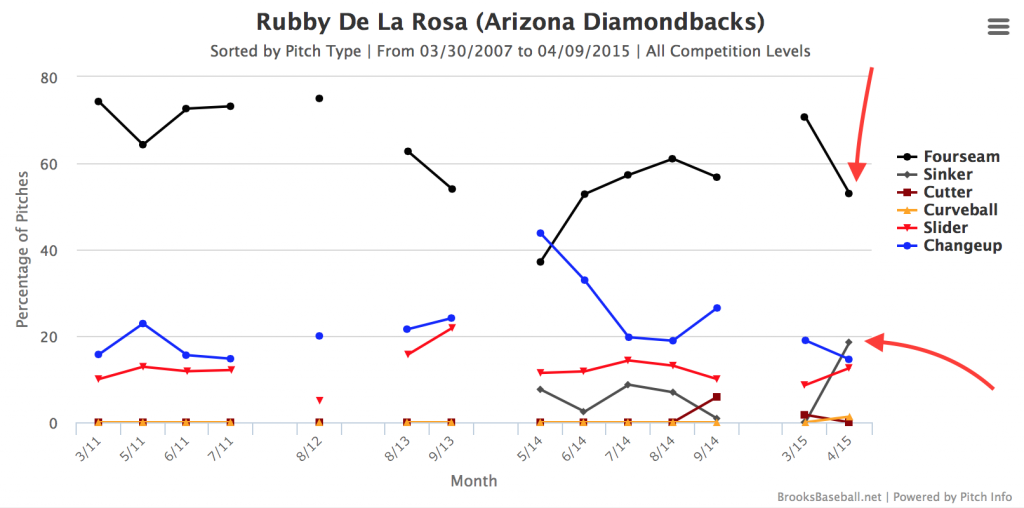More Fastballs, Different Fastballs for Rubby
On Tuesday, Rubby De La Rosa started for the Diamondbacks. It was Arizona’s second game of the season. That made De La Rosa the D-backs’ number two starter, kind of. At least that’s how people thought of it, and when they did, a lot of them said, “hey, Rubby De La Rosa is our number two?” to which others responded, undoubtedly, “I guess,” because how could anyone really be sure? A number two starter is supposed to be good. Rubby De La Rosa really hasn’t been, so you can see where the confusion lies. And one of the reasons he hasn’t been good is because he doesn’t really mix up his pitches. That can be problematic.
Big league hitters are good and even though hitting a baseball is exceedingly difficult, they manage to do it pretty well. That’s why they make the big bucks, as they say. Pitches work on a sort of double axis scale. On one axis is a batter’s perceived difficulty in hitting a pitch. The other axis is the pitcher’s perceived ability to throw said pitch for a strike. It’s a sort of yin and yang relationship for most pitchers, De La Rosa included. He’s struggled with his pitches, though, which is why he’s not very good. I’m not sure if it’s too much yin or too much yang, but I have a pretty good idea it’s too many fastballs. Yes, the bulk of fastballs have been a problem.
In 2014, De La Rosa threw some sort of heat 67% of the time. You’re probably proficient at math, but just in case, that means that two out of every three pitches was a fastball. Now I don’t know about you, but with that kind of overwhelming tendency, it’s not inconceivable to think that hitters sat back and waited for a fastball. Given the information above, that would be a pretty worthwhile strategy. And if you have an idea of the velocity a pitch is coming, you can probably start to get a feel for the timing needed to hit said pitch. Relying on that many fastballs signals a problem in and of itself.
But De La Rosa tries to at least mix it up by using two different kinds of fastballs, a four-seamer and a two-seamer (sinker). Although they are definitely different pitches, the results were pretty much the same in 2014. Take a look for yourself.
Most of the above information would paint the picture that the two fastballs were nearly identical, at least from an outcomes-based perspective. The value of the pitches was at least somewhat split where the two-seamer outpaced the four-seamer over the course of 2014, although neither was actually “good”. But, De La Rosa threw the two seam fastball far less. So it would stand to reason that he’d throw it more frequently in 2015. Lo and behold, take a look at the numbers from his last spring start:
We see a clear move towards more two seamers and away from so many four seamers in his last start of Spring Training. And, sure enough, we saw it on Tuesday night, too. There are 11 fastballs that went unclassified, but if we pepper them in at the confirmed rate, we see a clear change from last season.

So, yeah, there’s been a change in Rubby’s fastball usage. Unfortunately, it wasn’t effective. Of the confirmed fastballs we saw, here’s how they worked out:

That’s not a real good rate of strikes considering these are De La Rosa’s bread and butter. They also yielded six hits and eleven outs, all of the outs that De La Rosa recorded. Now, it’d be easy to say, “hey, that’s how he got guys out,” but to that I’d reply, “hey, he gave up six runs in four and two-thirds innings.” Recording outs is good and all, but only if you don’t let guys score. He let guys score.
And that leaves us with an interesting dilemma. Where does he go from here? True, it was just one start and the Diamondbacks have every reason to continue using him, but by throwing so many fastballs, one has to wonder if hitters can literally just sit on them. Case in point: with two down and a runner on second, Buster Posey expected a fastball from De La Rosa to begin his at-bat. He got one, a two seamer, and didn’t miss it.
Later, in the fourth, Brandon Belt was up in the count and had a high probability of receiving the heat. He got it, another two seamer, and drove in a run.
That pitch wasn’t particularly bad, it was down and away, but by being able to time the pitch and know what to look for, Belt simply hit it where it was pitched and drew the Giants within a run. Given the rate at which De La Rosa throws fastballs, why would he have been looking for anything else?
Now, Rubby threw a handful of good sliders and has a mediocre changeup or two, but until he’s able to mix these in more effectively, and more frequently, hitters will still sit fastball. And that’s bad for the Diamondbacks. Fastballs aren’t hard to hit for major league hitters. Even if they’re reasonably well-located and in the mid-90’s, if they’re expected, they get hit. He’s going to need to establish something else to avoid becoming a reliever, something I, and many others, have projected. He should get plenty of chances given the competition, but should he not improve by June, De La Rosa could find himself out of a rotation spot.
That’s not what you want to hear about your “number two” starter.
8 Responses to More Fastballs, Different Fastballs for Rubby
Leave a Reply Cancel reply
Recent Posts
@ryanpmorrison
 Congrats to @OutfieldGrass24 on a beautiful life, wedding and wife. He deserves all of it (they both do). And I cou… https://t.co/JzJtQ7TgdJ, Jul 23
Congrats to @OutfieldGrass24 on a beautiful life, wedding and wife. He deserves all of it (they both do). And I cou… https://t.co/JzJtQ7TgdJ, Jul 23 Best part of Peralta’s 108 mph fliner over the fence, IMHO: that he got that much leverage despite scooping it out… https://t.co/ivBrl76adF, Apr 08
Best part of Peralta’s 108 mph fliner over the fence, IMHO: that he got that much leverage despite scooping it out… https://t.co/ivBrl76adF, Apr 08 RT @OutfieldGrass24: If you're bored of watching Patrick Corbin get dudes out, you can check out my latest for @TheAthleticAZ. https://t.co/k1DymgY7zO, Apr 04
RT @OutfieldGrass24: If you're bored of watching Patrick Corbin get dudes out, you can check out my latest for @TheAthleticAZ. https://t.co/k1DymgY7zO, Apr 04 Of course, they may have overtaken the league lead for outs on the bases just now, also...
But in 2017, Arizona ha… https://t.co/38MBrr2D4b, Apr 04
Of course, they may have overtaken the league lead for outs on the bases just now, also...
But in 2017, Arizona ha… https://t.co/38MBrr2D4b, Apr 04 Prior to the games today, there had only been 5 steals of 3rd this season (and no CS) in the National League. The… https://t.co/gVVL84vPQ5, Apr 04
Prior to the games today, there had only been 5 steals of 3rd this season (and no CS) in the National League. The… https://t.co/gVVL84vPQ5, Apr 04
Powered by: Web Designers@outfieldgrass24
 Have always said it: all of his stuff moves and he’s a competitor. Guy has just struggled to find the zone and hone… https://t.co/YCguhhspUZ, 9 hours ago
Have always said it: all of his stuff moves and he’s a competitor. Guy has just struggled to find the zone and hone… https://t.co/YCguhhspUZ, 9 hours ago Reds?, 10 hours ago
Reds?, 10 hours ago RT @OutfieldGrass24: I have a feeling that today he will be Made Wiley https://t.co/a4PnfaPS7E, 19 hours ago
RT @OutfieldGrass24: I have a feeling that today he will be Made Wiley https://t.co/a4PnfaPS7E, 19 hours ago RT @nickpiecoro: The Diamondbacks lost, 6-2. They dropped three of four to the Padres. They looked sloppy, fundamentally unsound and… https://t.co/AUCgxJkkxN, 14 hours ago
RT @nickpiecoro: The Diamondbacks lost, 6-2. They dropped three of four to the Padres. They looked sloppy, fundamentally unsound and… https://t.co/AUCgxJkkxN, 14 hours ago Old, albeit brief, friend alert https://t.co/qnV5V7nIaF, 14 hours ago
Old, albeit brief, friend alert https://t.co/qnV5V7nIaF, 14 hours ago
Powered by: Web Designers







I thought his change-up looked great but he didn’t throw it enough. I actually thought it was his best pitch. He certainly wasn’t blowing anyone away with his fastball which is pretty discouraging for a pitcher who’s know for his “power”. I hope he’s on a very short leash as both Delgado and Hudson have looked much better (although the latter might not be a viable replacement). I think RDLR could fill a long-man role as well as either of those two and might be very good coming in after Collmenter or Hellickson for the same reason he was sandwiched in between them in the rotation.
That’s a great point and it’s one I meant to work into the piece but didn’t. He was “number two” because Hale thought his profile differed enough from Collmenter and Hellickson that he could sort of change the pace, which would presumably benefit him and Hellickson. Neither appeared to be the case.
These sorts of ideas do make some logical sense, but if we try to quantify this stuff, the changes usually seem to be extremely negligible. There’s just so much “meh” in this rotation that I don’t really care how you order it. The true talent level (low) is going to shine through either way.
You can see the velocity of his fastballs in the video clips linked. He’s mid-90’s with it, but mid-90’s isn’t enough to miss bats. Look at his whiff rates in 2014 with both fastballs. They’re low, even considering that FB’s don’t generate a ton of swings and misses. Whether he’s tipping them or batters are just sitting on them, it doesn’t matter, the pitches are ultimately ineffective.
If he were to head to the bullpen, we might be able to expect the velocity to pick up a little bit. If that were the case, perhaps he misses a few more bats. Ultimately, I believe that’s where he ends up. He’d need to make some significant progress to remain a starter. The changeup might be the place to begin that progress.
The hard thing about this staff, is if they cant consistently throw strikes the team will be dysfunctional, even if the score is in range.I don’t know, we all know its going to be a long year for our staff, hopefully they develop.
Right, progress is the name of the game. The fact is, for every one guy who grows, two will either stay the same or diminish. Part of the rebuilding process is asset assessment. This is that part.
[…] into the season, one situation we were keeping a close eye on was Rubby De La Rosa‘s reliance on fastballs, which seemed to cause a problem for him in Boston, and seemed to make him something of a […]
[…] Piecoro wrote yesterday, RDLR’s change seemed to make all the difference. Who knew that with so many fastballs in the mix, the key might be a pitch other than the […]
[…] that high a percentage of four-seam fastballs this season; as reliant as Rubby De La Rosa has been on fastballs in the past, he’s right around 60% this season, and that’s combining four-seams and […]
[…] into this season, Rubby De La Rosa was heavily reliant on his four-seam fastball, adding a few sinkers in 2014 but really only using a slider and a change to break up the fastball […]